语言学笔记-语言
《语言学教程》中文笔记(完整)

语言学教程笔记第一章语言学导论语言的定义特征:从本质上将人类语言与动物语言区分开的人类语言的区别性特点。
1. 任意性:任意性是指语言符号的形式与所表示的意义没有天然的联系,任意性是语言的核心特征。
例如,我们无法解释为什么一本书读作 a /buk/,一支钢笔读作a /pe n/。
任意性具有不同层次:(1)语素音义关系的任意性。
(2)句法层面上的任意性。
(3)任意性和规约性。
2. 二层性:二层性是指拥有两层结构的这种特性,上层结构的单位由底层结构的元素构成,每层都有自身的组合规则。
话语的组成元素是本身不传达意义的语音,语音的唯一作用就是相互组合构成有意义的单位,比如词。
因为底层单位是无意的,而上层单位有明确的意义,所以我们把语音叫做底层单位,与词等上层单位相对。
二层性使语言拥有了一种强大的能产性。
3. 创造性:创造性指语言的能产性,指语言有制造无穷长句的潜力,这来源于语言的二层性和递归性。
利用二重性说话者可以通过组合基本语言单位,无止境地生成句子,大多数都是以前没有过的或没有听过的。
4. 移位性:是指人类语言可以让使用者在交际时用语言符号代表时间上和空间上并不可及的物体、时间或观点。
因此我们可以提及孔子或北极,虽然前者已经去世两千五百五十多年而后者位置距我们非常之远。
语言使我们能够谈及已不存在或还未出现的事物。
移位性赋予人们的概括与抽象能力使人类受益无穷。
词在指称具体物体时,并不总是出现在即时、形象化的语境中。
他们通常为了体现指称含义而被使用。
5. 文化传递性:语言不是靠遗传,而是通过文化传递的。
6. 互换性:指人可以是信息的发出者,也可以是信息的接受者,即人作为说话者和听话者的角色是可以随意更换的。
元语言功能:我们的语言可以用来讨论语言本身。
比如说,我可以用“书”指代一本书,也可以用“书这个词”来指代“书”这个词本身。
这使语言具有无限的自我反身性:人类可以谈论“说话”,也可以思考“思考"。
胡壮麟《语言学教程》笔记1-3章

胡壮麟语言学重难点Chapter 1 Invitations to Linguistics常考考点:1. 语言: 语言的定义;语言的基本特征;语言的功能;语言的起源2. 语言学:语言学的定义;现代语言学与传统语法学研究的三个显著区别;语言学研究的四个原则及简要说明;语言学中的几组重要区别;每组两个概念的含义、区分及其意义;普通语言学的主要分支学科及各自的研究范畴;宏观语言学及应用语言学的主要分支及各自的研究范畴。
1. 语言的定义特征1.1. 任意性1.2. 二重性1.3. 创造性1.4. 移位性1.5. 文化传递性1.6. 互换性2. 语言的功能1.1. 信息功能1.2. 人际功能1.3. 施为功能1.4. 感情功能1.5. 寒暄功能1.6. 娱乐功能1.7. 元语言功能3. 微观语言学3.1. 语音学3.2. 音系学3.3. 形态学3.4. 句法学3.5. 语义学3.6. 语用学4. 宏观语言学4.1. 心理语言学4.2. 社会语言学4.3. 应用语言学4.4. 计算语言学4.5. 神经语言学5. 重要概念及其区分5.1. 描写式&规定式5.2. 共时&历时5.3. 语言&言语5.4. 语言能力&语言应用5.5. 唯素的&唯位的5.6. 传统语法&现代语法5.7. 语言潜势&实际语言行为Chapter 2 Speech Sounds常考考点:1. 语音学语音学的定义;发音器官的英文名称;英语辅音的定义;发音部位、发音方法和分类;英语元音的定义和分类;基本元音;发音语音学;听觉语音学;声学语音学;语音标记,国际音标;严式与宽式标音法2. 音系学音系学的定义;音系学与语音学的联系与区别;音素、音位、音位变体、最小对立体、自由变体的定义;音位理论;自由变异;音位的对立分布于互补分布;语音的相似性;区别性特征;超语段音位学;音节;重音;音高和语调。
语言学笔记

语言学笔记总体把握:比例:绪论总论25%绪论:语言学的性质和任务、方法和分类、回顾和小结、作用和意义。
总论:从宏观的角度介绍语言的本质和发展,语言的本质主要从语言和言语的区别与联系、语言的社会功能、语言的内部的大致结构等三方面阐述的。
语言的发展主要掌握发展的原因、规律特点、发展过程及结果。
题型:解词、填空、选择、结合例子简答或论述。
语音25%-30%掌握了生理属性(发音器官的三大部位)、物理属性(语音四要素)后,要全力掌握语音物质外壳的各种结构单位,即音素、音位、音节和语流。
音位集中体现了语音的社会属性,是全章的重点,划分与归并音位的原则是每次必考的问题。
英语和汉语的元音与辅音音素。
把汉语的元音与辅音的描写方法尽量记熟。
题型:解词、选择、填空、综合运用。
语义25%语义的定义、语言意义和言语意义的区别。
语言意义的重点在词汇意义(词义)上,如词义的性质特点特别是对词义的义素分析及词义的聚合类——语义场。
义素分析重点对亲属词及近义词的分析。
言语意义主要是研究语义与语境的关系如语境对语义的影响、语义在语境中变化的模式。
语义变化的原因、途径、结果。
词汇15%—20%词汇的重点在语素(词素)和词及词组的定义和区别、语素的分类(词根、词缀和词尾)、词的构词法及词的结构类型(语音构词、语义构词和语法构词以及合根法、附加法和减缩法)。
词汇的分类和固定词组等。
语法20%要结合外语和汉语的例子进行。
对词的分类范畴要注意分类标准。
句法的内部意义有显性意义和隐形意义。
显性意义主要指陈述、修饰、支配、平行、补充等关系和主谓、偏正、动宾、联合、后补等结构。
分析层次性的方法——直接成分分析法,尤其是对歧义句的分析。
结合层次分析的树形图、句式转换的规则。
文字5%文字的性质、作用、起源、发展、类别及改革与创制交叉语言学不考一、绪论名词:语言学、语言学概论、历史语言学、对比语言学、历史比较语言学、描写语言学、历时语言学、共时语言学、个别语言学、组合关系、聚合关系、普通语言学、微观语言学、宏观语言学、理论语言学、语文学、语言、言语、思维、符号、渐变性、参差性、语言的分化、语言的整化、语言的融合知识点:1、印度、希腊与罗马、中国,被认为是语文学的三个源头。
《语言学概论》复习笔记
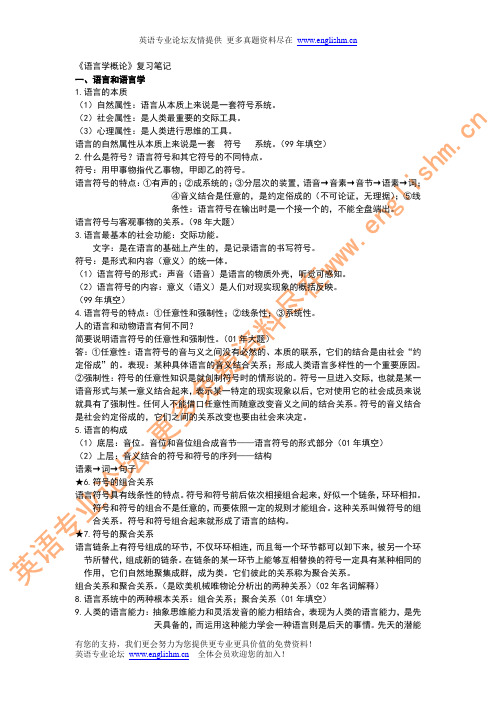
《语言学概论》复习笔记一、语言和语言学1.语言的本质(1)自然属性:语言从本质上来说是一套符号系统。
(2)社会属性:是人类最重要的交际工具。
(3)心理属性:是人类进行思维的工具。
语言的自然属性从本质上来说是一套符号系统。
(99年填空)2.什么是符号?语言符号和其它符号的不同特点。
符号:用甲事物指代乙事物,甲即乙的符号。
语言符号的特点:①有声的;②成系统的;③分层次的装置,语音→音素→音节→语素→词;④音义结合是任意的,是约定俗成的(不可论证,无理据);⑤线条性:语言符号在输出时是一个接一个的,不能全盘端出。
语言符号与客观事物的关系。
(98年大题)3.语言最基本的社会功能:交际功能。
文字:是在语言的基础上产生的,是记录语言的书写符号。
符号:是形式和内容(意义)的统一体。
(1)语言符号的形式:声音(语音)是语言的物质外壳,听觉可感知。
(2)语言符号的内容:意义(语义)是人们对现实现象的概括反映。
(99年填空)4.语言符号的特点:①任意性和强制性;②线条性;③系统性。
人的语言和动物语言有何不同?简要说明语言符号的任意性和强制性。
(01年大题)答:①任意性:语言符号的音与义之间没有必然的、本质的联系,它们的结合是由社会“约定俗成”的。
表现:某种具体语言的音义结合关系;形成人类语言多样性的一个重要原因。
②强制性:符号的任意性知识是就创制符号时的情形说的。
符号一旦进入交际,也就是某一语音形式与某一意义结合起来,表示某一特定的现实现象以后,它对使用它的社会成员来说就具有了强制性。
任何人不能借口任意性而随意改变音义之间的结合关系。
符号的音义结合是社会约定俗成的,它们之间的关系改变也要由社会来决定。
5.语言的构成(1)底层:音位。
音位和音位组合成音节——语言符号的形式部分(01年填空)(2)上层:音义结合的符号和符号的序列——结构语素→词→句子★6.符号的组合关系语言符号具有线条性的特点。
符号和符号前后依次相接组合起来,好似一个链条,环环相扣。
语言学笔记大全

同样的意义内容,在不同的语言中有不同的语音形式,这是不同的社会习惯决定的,是不同的民族在创造这个词的时候选择了不同的语音形式,各个社会的成员约定俗成的,因为语音形式和意义的联系是任意的,非本质的,所以不同语言之间出现这样的差异就不奇怪了。
四、怎样理解语言符号的任意性和线条性特点?
任意性和线条性是语言符号的两个最基本的特点。语言符号的任意性是指语言符号的音义关系是由社会约定的,用什么样的“音”去表达什么样的“义”人们说不出什么道理,完全由社会约定,这种音义关系又叫约定性;语言符号的线条性是指符号的使用只能在时间的线条上绵延,一个符号跟着一个符号依次出现。如以“小王打碎了杯子”为例,每个字只能顺着时间的先后一个跟着一个说出来,绝不能在同一时点同时蹦出两个字来。依次出现的符号要遵守一定的规则,不能随意编排。这就是说,符号的线条性是由规则支配的,对社会成员具有强制性。如“我吃饭”不能说成“饭吃我”。但是,语言又是不断发展变化的,具有可变性特点。如一些新词的出现,一字词的新用法。这种变化,又从另一个方面说明了语言符号的任意性特点,也即语言符号的音义联系是社会约定的,而不是天然的、本质的联系。
4、用“棋、下、有、一、完、没、的、盘”这八个词组成句子,看能组合成多少句子?
这些词可以组合成下列句子:
一盘没有下完的棋、没有下完的一盘棋、没有一盘下完的棋、没下完的棋有一盘、下完的棋一盘没有、下完的棋没有一盘、有一盘没下完的棋、有没下完的一盘棋、棋没下完的有一盘、棋有一盘没下完……
5、语言实际上是一种社会现象,怎样理解这句话?
二、什么是语言符号?为什么说语言是一种符号系统?
语言学概论经典复习笔记(全)
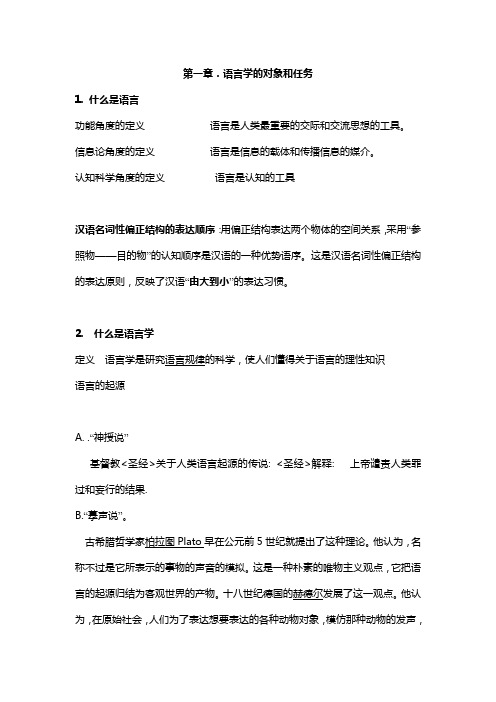
第一章.语言学的对象和任务1. 什么是语言功能角度的定义语言是人类最重要的交际和交流思想的工具。
信息论角度的定义语言是信息的载体和传播信息的媒介。
认知科学角度的定义语言是认知的工具汉语名词性偏正结构的表达顺序:用偏正结构表达两个物体的空间关系,采用“参照物——目的物”的认知顺序是汉语的一种优势语序。
这是汉语名词性偏正结构的表达原则,反映了汉语“由大到小”的表达习惯。
2. 什么是语言学定义语言学是研究语言规律的科学,使人们懂得关于语言的理性知识语言的起源A. .“神授说”基督教<圣经>关于人类语言起源的传说: <圣经>解释: 上帝谴责人类罪过和妄行的结果.B.“摹声说”。
古希腊哲学家柏拉图Plato早在公元前5世纪就提出了这种理论。
他认为,名称不过是它所表示的事物的声音的模拟。
这是一种朴素的唯物主义观点,它把语言的起源归结为客观世界的产物。
十八世纪德国的赫德尔发展了这一观点。
他认为,在原始社会,人们为了表达想要表达的各种动物对象,模仿那种动物的发声,比如拟声词。
C.“感叹说”。
古希腊哲学家伊壁鸠鲁(Epicurus, 公元前341~前270年)是其代表人物这种理论认为,原始人的感情冲动、受到惊恐后发出的喊叫等,也就是出于内心和外来的感受而发出的声音逐渐发展为感叹词,最终形成了语言。
D.“号子说”。
19世纪的法国哲学家努阿尔认为,原始人在集体劳动时会发出“咳哟”、“啊哈”等声音,以协调劳动的一致性,大致相当于今天的劳动号子,这就形成语言最初的成分——动词。
E.“劳动说”。
恩格斯首先提出来的。
恩格斯认为:一方面“劳动的发展必然促使社会成员更紧密地互相结合起来因为它使互相帮助和共同协作的场合增多了,并且使每个人都清楚地意识到这种共同协作的好处。
另一方面,劳动还使人的发音器官和大脑发达起来。
这些都是语言诞生的必要条件。
3语文学A 定义:为注解古代经典(如政治、哲学、历史、文学等经典作品),而对其中的文字\词汇\语法所作的研究.语文学是经学的附庸,没有把语言作为独立的学科研究. 又叫“前语言学”.印度宗教经典梵语:语音、语法研究西欧(希腊-罗马)古典拉丁文:语法、修辞、逻辑中国先秦典籍:汉字形音义研究三个重要的传统古印度巴尼尼<梵语语法>古希腊-罗马底奥尼修<希腊语法> 瓦罗《论拉丁语》中国“小学”中国第一部语法专著马建忠《马氏文通》(1898)采用的也是拉丁语的体系。
语言学概论笔记
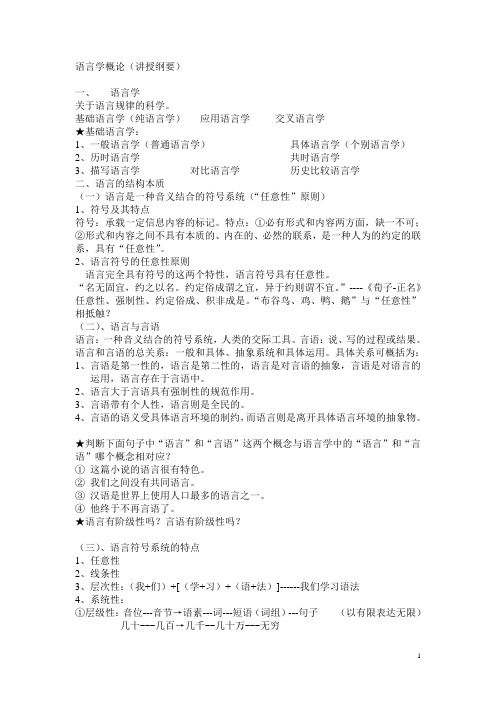
语言学概论(讲授纲要)一、语言学关于语言规律的科学。
基础语言学(纯语言学)应用语言学交叉语言学★基础语言学:1、一般语言学(普通语言学)具体语言学(个别语言学)2、历时语言学共时语言学3、描写语言学对比语言学历史比较语言学二、语言的结构本质(一)语言是一种音义结合的符号系统(“任意性”原则)1、符号及其特点符号:承载一定信息内容的标记。
特点:①必有形式和内容两方面,缺一不可;②形式和内容之间不具有本质的、内在的、必然的联系,是一种人为的约定的联系,具有“任意性”。
2、语言符号的任意性原则语言完全具有符号的这两个特性,语言符号具有任意性。
“名无固宜,约之以名。
约定俗成谓之宜,异于约则谓不宜。
”----《荀子-正名》任意性、强制性、约定俗成、积非成是。
“布谷鸟、鸡、鸭、鹅”与“任意性”相抵触?(二)、语言与言语语言:一种音义结合的符号系统,人类的交际工具。
言语:说、写的过程或结果。
语言和言语的总关系:一般和具体、抽象系统和具体运用。
具体关系可概括为:1、言语是第一性的,语言是第二性的,语言是对言语的抽象,言语是对语言的运用,语言存在于言语中。
2、语言大于言语具有强制性的规范作用。
3、言语带有个人性,语言则是全民的。
4、言语的语义受具体语言环境的制约,而语言则是离开具体语言环境的抽象物。
★判断下面句子中“语言”和“言语”这两个概念与语言学中的“语言”和“言语”哪个概念相对应?①这篇小说的语言很有特色。
②我们之间没有共同语言。
③汉语是世界上使用人口最多的语言之一。
④他终于不再言语了。
★语言有阶级性吗?言语有阶级性吗?(三)、语言符号系统的特点1、任意性2、线条性3、层次性:(我+们)+[(学+习)+(语+法)]------我们学习语法4、系统性:①层级性:音位---音节→语素---词---短语(词组)---句子(以有限表达无限)几十---几百→几千--几十万---无穷(音位层)(符号层)②组合关系和聚合关系组合关系:符号和符号组合起来的关系。
语言学纲要笔记第一章

第一章语言的功能语言的功能是多方面的,从宽泛的意义讲,大致都可以归入语言的社会功能和思维功能两方面。
第一节:语言的社会功能语言的社会功能:信息传递功能和人际互动功能。
一、语言的信息传递功能:信息传递功能是最基本的社会功能。
这一功能体现在语言上就是内容的表达。
各种信息传递形式的比较:身势等非语言的形式,独自传递的信息有限,多半是辅助语言来传递信息;文字是建立在语言基础之上的再编码形式;旗语之类则是在语言或文字基础之上的再编码形式;语言是人类社会信息传递第一性的、最基本的手段。
二、语言的人际互动功能建立或保持某种社会关联,即是语言的人际互动功能。
可以这样理解:说话者在传递客观经验信息的同时,在也表达主观的情感、态度和意图,寻求听话者的反馈。
而受话者在接收说话者传递的客观信息的同时,也了解了说话者的主观情感态度,从而做出回应。
说话者———————————————————————————→受话者(寻求反馈)传递客观经验信息;表达主观情感、态度和意图(做出回应)第二节:语言的思维功能一、语言和思维的关系语言是社会现象,是社会的交际工具,同时也是心理现象,是人类思维的工具。
思维功能是语言功能的另一个重要方面。
二、语言思维功能的生理基础大脑是语言思维功能的生理基础,语言功能区主要存在于左半球。
(左半球掌管抽象、概括的思维,右半球掌管不需要语言的感性直观思维)(不过,人脑分工是存在的,但其运用是综合性的)。
三、儿童语言习得和思维的发展1.独词句→双词句(孩子学话中的关键的两步)从某类概念→不同事物的区别和不同事物中共同的东西,同时把统一的事物分析成不同的要素。
独词句体现了词与事物的联系,特别是词指称整类事物的概括性。
双词句体现了造句的基本原理,就是选择需要的词,按照学会的格式把它们组合在一起。
2.大体发展趋势:独词句→双词句→实词句→虚词的掌握→熟练运用语言也就是外界的现象概念范畴化的过程。
3.儿童语言习得的条件:儿童语言习得一定得具有先天生理基础,其中最重要的就是大脑的结构和功能。
语言学概论笔记(第一章)

语言学概论笔记第一章:语言和语言学一、识记内容。
1、口语:语言的客观存在形式首先是有声的口头语言。
2、书面语:文字出现以后,语言的第二种客观存在形式。
3、符号:指的是根据社会的约定俗成使用某种特定的物质实体来表示某种特定的意义而形成的这种实体和意义的结合体。
4、能指:语言符号的物质实体能够指称某种意义的成分。
5、所指:也就是“能指成分”,即特定的物质实体,所指的意义内容。
6、聚合关系:在同一个位置上可以互相替换出现的各个语言单位处在互相可以联想起来的关系之中,因而聚合成为一个类。
7、组合关系:组合关系体现为一个语言单位和前一个语言单位或后一个语言单位,或和前后两个语言单位之间的关系,也体现了部分与整体之间的关系。
8、语言学:是研究语言的科学。
9、普通语言学:语言学界把研究人类社会的语言这种社会现象的一般理论。
10、理论语言学:把研究某种具体语言的语言学称为汉语语言学或英语语言学等等,把侧重理论探讨的称为理论语言学。
11、应用语言学:把侧重语言学理论和成果的实际应用。
12、传统语言学:一般泛指20世纪以前的语言学,特别是指索绪尔开创的结构主义语言学以前的语言学。
13、结构主义语言学:索绪尔创立的语言学可以称为“结构主义语言学”,至于我国内常说的“结构主义语言学”、“结构主义语法”,往往只是指在国外影响较大并且我国语言学界比较熟悉的美国结构主义描写语言学,那只是当代结构主义语言学的一个流派,并不等于受索绪尔影响的整个结构主义语言学。
二、领会内容(不用识记,大体知道即可)1、言语交际是一个编码和解码的过程。
答:人要说话所需要的因素:生活经历、社会环境、当前处理的问题、社会问题、文化问题、哲学问题、逻辑问题。
人要接受语言所需要的因素:组织与分析的能力、心理、生理问题;发音、听音的器官和神经网络及机制和能力;复杂的生理和物理问题。
总之一句话,言语交际是通过许多因素对语言进行编码和解码的过程,言者编码,听者解码。
语言学笔记

语言学笔记一、语言学的定义和研究对象语言学是研究语言现象的学科,主要研究人类语言的性质、结构、发展及其在社会生活中的运用。
语言学的研究对象包括语言的语音、语法、语义、语用等方面。
二、语言的基本特征1. 符号性:语言是一种符号系统,符号包括能指和所指两个方面。
能指是符号的物质形式,所指是符号所代表的意义。
2. 任意性:语言符号的能指和所指之间的关系是任意的,没有必然的联系。
这种任意性是语言符号系统的基础。
3. 层次性:语言结构具有层次性,包括语音层、语法层、语义层和语用层等。
每个层次都有其独特的结构和规则。
4. 生成性:语言具有生成性,即有限的语言规则可以生成无限多的语言表达式。
这是语言创造力的重要体现。
5. 社会性:语言是一种社会现象,是社会交际的工具。
语言的运用受到社会文化、经济、政治等多种因素的影响。
三、语言学的主要分支1. 语音学:研究语言的语音系统,包括音位、音变、音系等方面的研究。
2. 音系学:研究语言的音节结构和音系规则,揭示语言的音节组成和音系演变规律。
3. 形态学:研究词的内部结构和构词规则,揭示词的形态变化和构词规律。
4. 句法学:研究句子的结构规则和组合规律,揭示句子的句法关系和语义关系。
5. 语义学:研究语言的意义系统,包括词义、句义、篇章意义等方面的研究。
6. 语用学:研究语言在实际运用中的功能和效果,包括语境、会话含义、言语行为等方面的研究。
四、语言学的研究方法1. 描述法:对语言现象进行客观描述和分析,揭示语言的本质特征和规律。
2. 比较法:通过对不同语言或同一语言不同方言的比较研究,揭示语言的共性和差异。
3. 实验法:通过实验手段对语言现象进行实证研究,验证语言学理论和假设。
4. 历史法:通过对语言历史演变的研究,揭示语言的发展规律和演变趋势。
5. 数学法:运用数学方法和模型对语言现象进行定量分析和模拟研究,揭示语言的数学模型和内在规律。
五、语言学的学习意义和价值1. 提高语言能力:通过学习语言学知识,可以更好地掌握和运用语言,提高听说读写译等语言能力。
语言学概论 自考笔记

语言学概论第一章语言和语言学第一节认识人类的语言一、只有人类才有语言(领会)(多选)(一)人类语言与其他动物鸣叫系统的区别:1、内容更多。
2、用处更大。
3、能够创造。
(二)人类具有语言能力,是人类跟其他动物区别的最重要的标志。
(单选)二、语言和民族、国家之间的关系(领会)(单选)(论述)(一)语言不但是最直观和最易识别的民族标志,同时还是国家的标志。
(二)语言和民族、语言和国家之间存在着复杂的关系。
(为什么汉语中吴语、粤语、闽语相互听不懂但仍属于汉语)(综合应用)1、一个民族使用一种语言。
2、西方学者把“相互能够听懂”作为确定语言的标准。
这种标准对于历史悠久、幅员辽阔的国家则不适用。
3、“语言”和“民族”之间、“民族”和“国家”之间错综复杂的情况,才有做出更加符合客观事实的结论。
三、语言特点与语言类型(说明不同类型语言的主要特点)(简单应用)(一)语言的谱系分类(领会)(名词解释)1、语言谱系分类:从语言“历时”状态角度来划分,根据各种语言在语音、语汇、语法等方面是否有共同的来源和相似性的大小对语言进行的分类。
2、了解怎样区别不同的语言和不同的方言(领会)(单选)(多选):(1)谱系层次:语系—语族—(语支)—语言—方言—次方言(土语)(2)语系(识记):属于同一个语系的语言都有古老的共同来源。
其中印欧语系和汉藏语系是两个最大的语系。
(3)语族(识记):同一语族的语言不但有相同的来源,相似点也更多。
(二)语言的形态分类(领会)1、语言形态分类(名词解释):从语言“共时”状态角度来划分不同的语言,其中一种主要的分类结果就是把人类语言分成“形态语”和“孤立语”,或者分成“综合性语言”和“分析性语言”。
2、“形态语”和“综合性语言”(识记)(名词解释):通过词的形态变化来体现各种结构意义的语言。
(1)屈折语(识记)(名词解释):主要是句子中某些词本身有丰富的形态变化,典型的如德语、俄语。
(2)黏着语(识记)(名词解释):主要是句子中某些词的形态变化表现为在词的前后附有词缀,典型的如维吾尔语、日语。
语言学纲要笔记

语言学纲要笔记第一章 语言的功能一、语言是什么?1、语言是音义结合的符号系统,人类最重要的交际工具和思维工具。
2、a 人类的语言b 通过言语交际的能力c 一套语音系统以及产生意义的语音组合系统,用来表达交际思想和感受d 上述系统的书面表述社会功能语言是人类的社会的交际工具。
每个社会,无论是经济发达的社会还是经济十分落后的社会,都必须有自己的语言,都离不开语言这个交际工具,是不可少的一个因素。
人类与动物相区别的重要特征之一。
七大功能:信息功能——语言的主导功能人际功能——语言最重要的社会功能施为功能——可以执行某种行为 Eg: The bag is so heavy. 岁岁平安 感情功能——语言最有用的功能之一Eg:改变听者的态度;誓言;承受压力时摆脱紧张寒暄功能——语言的交互性娱乐功能——用处单一而有限 对歌、诗歌元语言功能 ——用自身研究自身(语言)第二章 语言是符号系统一、什么是符号?它有哪些因素构成?符号是一个社会全体成员共同约定用来表示某种意义的记号、标志。
语言符号: 形式:语音 风(能指)意义:气体的流动(所指)语言的核心特征——任意性语言符号任意性的作用二、层次性音位语言的层级体系,其音位层和符号层我们合称为语言的二层性底层无意义,上层有意义三、系统性组合关系:符号和符号相互结合起来的关系聚合关系:指在某一环节上具有相同作用的能够互相替换的符号间的关系四、递归性相同的规则可以再一个结构里重复使用五、文化的传递性人类的语言是由我们所接触的文化来传递的六、移位性使用音位交际时使用语言符号代表时间、空间上异不可及的物体、观点等。
第三章 语音一、什么是语音?什么是音节?什么是音系?1、语音是语言的物质材料,是人类的发音器官发出的代表一定意义的声音2、音节是音位和音位组合起来构成的最小的语音结构单位。
它是听觉上感受到的最自然底层语素 词 句子的单位。
比如我们说“我上课”很自然地辨别出这是由wo shang ke 这三个音节构成的3、音素是从音质角度划分出来的最小语音单位,音节往下切分,就是音素,比如音节wo 可以切分出w和o,一个音素只有一个发音动作,发音动作改变了,发音器官改变了,就发出了不同的音素。
语言学笔记-语言

1.Linguistics studies not any particular language, but languages in general.2.If a linguistic study aims to describe and analyze the language people atcutally use, it is said to be Descriptive(描述性) - synchronic study(共时研究)If the linguistic study aims to lay down rules for "correct and standard" behaviour in using language, it is said to be Perscriptive(规定性) - diachronic study(动态研究)3.Modern linguistic regards the spoken language as the nature or the primary medium of human language.ngue(语言) refers to the abstract linguistic system shared by all the members of a speech community; parole(话语) refers to the realization of langue in actual use.petence: the ideal(normal) user's knowledge of the rules of his language; Performance: the actual realization of the knowledge in linguistic communications.nguage is a system of arbitrary vocal symbols(语言符号系统) used for human communication.7.Displacement(移位性): It means language can be used to refer to contexts removed from the immediate situations of the speaker.(things which are present of not present, real or imagined matters in the past, present, or future, or far-away places.)8.V oicing(浊音): Vibration of the vocal cords(声带) results in a quality of speech sound called "voicing". It's the feature of all vowels and some consonants.V oiceless(清音): When the vocal cords are drawn wide apart, letting air go through without causing vibration, the sounds produced in such a condition are voiceless.9.Speech organs: the tongue, the uvula(小舌), the soft palate/velum, the hard palate, the teeth ridge/alveolus(齿龈), the teeth and the lips. The tongue is the most flexible, and is responsible for more varieties of articulation(发音) than any other10.English consonants classification: in therms of manner of articulation(发音方式); in terms of place of articulation(发音部位);voicing(浊音) and voiceless(浊音)11.Vowels sounds are differentiated by a number of factors: the position of the tongue in the mouth, the openness of the mouth, the shape of the lips, and the length of the vowels.(舌头位置, 开口度, 唇形, 音长度) 12.Phone(音素): a phonetic unit or segment. A phone doesn't necessarily distinguish meaning; Phoneme(音位): a phonological unit that is of distinctive value.13.Minimal pairs(最小对): when two different forms are identical in every way except for one sound segment which occurs in the same place in the strings, the two sound combinations are said to form a minimal pair.14.Suprasegmental features(音位特征): stress, tone, intonation(重音, 声调, 语调)15.A phonological feature of the English compounds in that the stress of the word always falls on the first element, and the second element receives secondary stress. (重音在另一个音节)16.Open class words: nouns, verbs, adjectives and adverbs. Closed class words: conjunctions, prepositions, articles and pronouns.17.Morphology(形态学) refers to the study of the internal structure of words, and the rules by which words are formed.18.Bound morphemes are never words but always parts of words, like -ish, -able. Free morphemes can constitute words by themselves like: girl,rely. We seldom use bound morphemes alone, we combine all morphemes into longer units and sentences.19.Category refers to a group of linguistic items which fulfill the same or similar funtions in a particular language such as a sentence, a noun phrase or a verb. Major lexical categories are noun, verb, adjective and preposition.20.Phrases that are formed of more than one word usually contain the following elements: head, specifier and complement.21.A certain grammatical mechanism that ensures the appropriate positions that specifiers, heads, complements occupy in phrase structure. Such special type of grammatical mechanism that regulates the arrangement of elements that make up a phrase is called a phrase structure rule.(短语结构规则)22.Not all verbs can take a CP complement. Words that can take CP are not verbs alone; As, Ns and Ps call all take CP.23.Transformation: a special type of rule that can move an element from one position to another.24.Wh question: question beginning with a wh-word.25.Contextualism(语境/情境因素)a word in a new context is a new word.26.Behaviorism(行为主义)27.Sense is concerned with the inherent meaning of the linguistic form.It is the collection of all the feature of the linguistic form; it is abstract and de-contextualized.28.Synonymy(同义)refers to the sameness or close similarity of meaning. Words that are close in meaning are called synonymy.29.Polysemy(一词多义)refers to the same one word may have more than one meaning. This word is called a polysemic.30.Homonymy(同音异义) refers to the phenomenon that words having different meanings have the same form, different words are identical in sound or spelling, or in both.31.Antonymy(反义词) words have oppositeness of meaning.ponential analysis(词义分析成分)is a way proposed by the structural semanticists to analyze word meaning.33.The meaning of a sentence is not the sum total of the meanings of all its components, that is, the meaning of a sentence is not to be worked out by adding up all the meanings of its constituent words. Predication analysis.(句意分析)34.Pragmatics(语用学) it is the study of how speakers of a language use sentences to effect successful communication.35.If the context of language use was left unconsidered it would be impossible to give an adequate description of meaning. What essentially distinguishes semantics and pragmatics is where in the study of meaning the context of use is considered.36.The notion of context is essential to the pragmatics study of language. It is generally considered as constituted by the knowledge shared by the speaker and the hearer.37.It all depends on how we look at it a nd how we are going to analyze it. If we take it as a grammatical unit(语法单位)and consider it as a self-contained unit(独立单元)in isolation from context, then we are treating it as a sentence.38.A speaker might be performing three acts simultaneously(同时地) when speaking: locutionary act, illocutionary act, perlocutionary act.(言内行为, 言外行为, 言后行为)39.According to Searle, speech acts fall into five general categories:1) Representatives: stating or describing, saying what the speaker believes to be true2) Directives: trying to get the hearer to do something3) Commissives: committing the speaker himself to some future course of action4) Expressives: expressing feelings or attitude towards an existing state5) Declarations: bringing about immediate changes by saying something 40.Cooperative principle/CP: 推断题1)The maxim of quantity/信息量过大, 不可2)The maxim of quality/无证据的认为是错的, 不说3)The maxim of relation/不相关的, 不说4)The maxim of manner/含糊不清的, 不说, 要简洁有条理41.Modern English/Old English: changes in phonology, morphology, syntax, lexicon, semantic components(音, 形, 句法, 词, 语义成分).42.判断用哪种方法造新词: coinage(创新法), clipped words(剪切法), blending(混拼法), acronyms(首字母缩略), back-formation(逆构法), functional shift(功能转变法), borrowing(借用法)43.判断词义扩大缩小: widening(词义扩大),narrowing(词义缩小)44.Speech community is defined as group of people who from a community and share the same language or a particular variety of a language.45.A social group may distinguish itself form the rest of the community by: the educational background, the occupation, the gender, the age, or the ethnic affiliation of its members.46.Sociolinguistic(社会语言学) studies three types of speech varieties: regional dialects(地域方言), sociolects(社会方言), registers(语域) 47.A regional dialect is a linguistic variety used by people living in the same geographical region. It is associated with separation caused by physical conditions.48.Social dialect has to do with separation brought about by different social conditions. Social-class dialect/sociolect, refers to the linguistic varieties characteristic of a particular social class.49.Register(语域或使用域)/functional speech variety(功能变体)/situational dialect(情境方言)50.Register: the type of language which is selected as appropriate to they type of situation.51.Three social variables(社会变量) that determine the register: field of discourse(话语范围), tenor of discourse(基调), model of discourse(方式).52.Linguistic relativity(语言相对性): different language offer people different ways of expressing the world around. This independence of language and thought is now known as Sapir-Whorf hypothesis(SWH).认为语言结构决定人类思维方式及行动方法的假说.53.Hypothesis/SWH is interpreted in two ways: Strong version believes that the language patterns determine people's thinking and behaviour, the weak one holds that the former influence the latter.54.Any linguistic sign(语言符号) may be simultaneously of a denotative(本体义), connotative(含蓄义), or iconic(形象义) kind of meanings.55.In addition to the fact that different language may have different divisions of colour, different languages entail different color related associations.56.The increasing cultural diffusion(文化传播) has been recognized a tendency of cultural imperialism(文化帝国主义) owing to linguistic imperialism(语言帝国主义).nguage acquisition(言语习得) refers to the child's acquisition of his mother tongue, i.e. How the child comes to understand and speak the language of his community .58.Traditional behaviorists(行为主义者) view language as behavior and believe that language learning is simply a matter of imitation and habit formation.59.Children need access to the samples of a natural language to activate the LAD(language acquisition device), which enables them to discover his language's structure by matching the innate(先天的) knowledge of basic grammatical system to that particular language. Chomsky prefers this innate endowment as Universal Grammar/UG(普遍语法)60.Only when conversations provide the right level of language that children are capable of processing can they facilitate children's language acquisition, otherwise it's insufficient.61.All child language acquisition theories talk about the roles of two factors to different degrees: the linguistic environment children are exposed to, the age they start to learn the language.62.Critical Period Hypothesis(关键期假设): the LAD works successfully only when it is stimulated at a specific and limited time period for language acquisition.63.Stages in child language development: phonological development, vocabulary development, grammatical development64.In learning second language distinguish was made between positive transfer (facilitate target language) and negative transfer(interfere) 65.Interlanguage(中介语)was established as learners' independent system of the second language which is neither the native language nor the second language, but a continuum or approximation from his native language to the target language.66.Individual differences: Language aptitude(语言学能): refers to a natural ability for learning a second language. Cognitive mechanism(认知机制). Motivation(学习动机): learner's attitudes and affective state or learning drive impacts strongly. A ge of acquisition(习得年龄). Personality(性格)...CPH存在于第二外语习得吗?。
语言学笔记重点
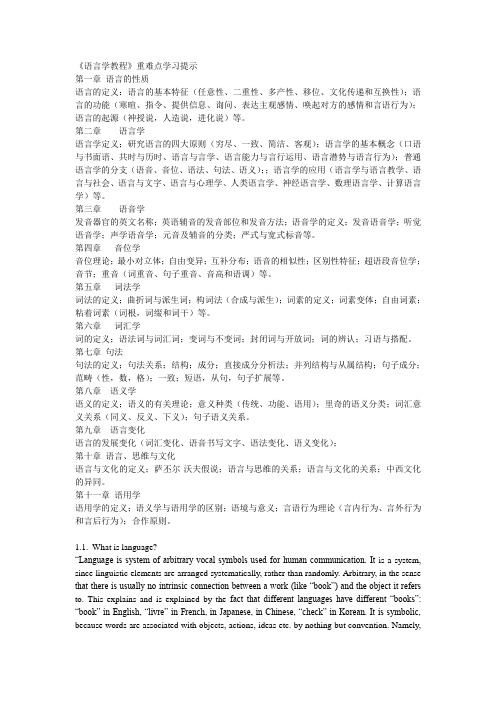
《语言学教程》重难点学习提示第一章语言的性质语言的定义:语言的基本特征(任意性、二重性、多产性、移位、文化传递和互换性);语言的功能(寒暄、指令、提供信息、询问、表达主观感情、唤起对方的感情和言语行为);语言的起源(神授说,人造说,进化说)等。
第二章语言学语言学定义;研究语言的四大原则(穷尽、一致、简洁、客观);语言学的基本概念(口语与书面语、共时与历时、语言与言学、语言能力与言行运用、语言潜势与语言行为);普通语言学的分支(语音、音位、语法、句法、语义);;语言学的应用(语言学与语言教学、语言与社会、语言与文字、语言与心理学、人类语言学、神经语言学、数理语言学、计算语言学)等。
第三章语音学发音器官的英文名称;英语辅音的发音部位和发音方法;语音学的定义;发音语音学;听觉语音学;声学语音学;元音及辅音的分类;严式与宽式标音等。
第四章音位学音位理论;最小对立体;自由变异;互补分布;语音的相似性;区别性特征;超语段音位学;音节;重音(词重音、句子重音、音高和语调)等。
第五章词法学词法的定义;曲折词与派生词;构词法(合成与派生);词素的定义;词素变体;自由词素;粘着词素(词根,词缀和词干)等。
第六章词汇学词的定义;语法词与词汇词;变词与不变词;封闭词与开放词;词的辨认;习语与搭配。
第七章句法句法的定义;句法关系;结构;成分;直接成分分析法;并列结构与从属结构;句子成分;范畴(性,数,格);一致;短语,从句,句子扩展等。
第八章语义学语义的定义;语义的有关理论;意义种类(传统、功能、语用);里奇的语义分类;词汇意义关系(同义、反义、下义);句子语义关系。
第九章语言变化语言的发展变化(词汇变化、语音书写文字、语法变化、语义变化);第十章语言、思维与文化语言与文化的定义;萨丕尔-沃夫假说;语言与思维的关系;语言与文化的关系;中西文化的异同。
第十一章语用学语用学的定义;语义学与语用学的区别;语境与意义;言语行为理论(言内行为、言外行为和言后行为);合作原则。
《语言学教程》中文笔记(完整)
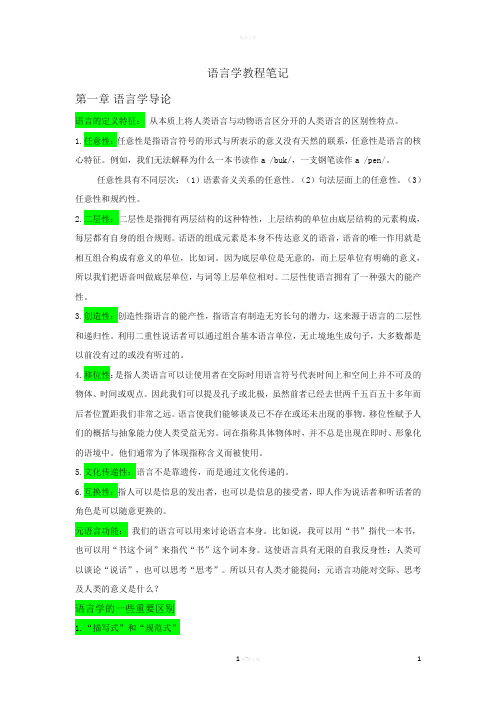
语言学教程笔记第一章语言学导论语言的定义特征:从本质上将人类语言与动物语言区分开的人类语言的区别性特点。
1.任意性:任意性是指语言符号的形式与所表示的意义没有天然的联系,任意性是语言的核心特征。
例如,我们无法解释为什么一本书读作a /buk/,一支钢笔读作a /pen/。
任意性具有不同层次:(1)语素音义关系的任意性。
(2)句法层面上的任意性。
(3)任意性和规约性。
2.二层性:二层性是指拥有两层结构的这种特性,上层结构的单位由底层结构的元素构成,每层都有自身的组合规则。
话语的组成元素是本身不传达意义的语音,语音的唯一作用就是相互组合构成有意义的单位,比如词。
因为底层单位是无意的,而上层单位有明确的意义,所以我们把语音叫做底层单位,与词等上层单位相对。
二层性使语言拥有了一种强大的能产性。
3.创造性:创造性指语言的能产性,指语言有制造无穷长句的潜力,这来源于语言的二层性和递归性。
利用二重性说话者可以通过组合基本语言单位,无止境地生成句子,大多数都是以前没有过的或没有听过的。
4.移位性:是指人类语言可以让使用者在交际时用语言符号代表时间上和空间上并不可及的物体、时间或观点。
因此我们可以提及孔子或北极,虽然前者已经去世两千五百五十多年而后者位置距我们非常之远。
语言使我们能够谈及已不存在或还未出现的事物。
移位性赋予人们的概括与抽象能力使人类受益无穷。
词在指称具体物体时,并不总是出现在即时、形象化的语境中。
他们通常为了体现指称含义而被使用。
5.文化传递性:语言不是靠遗传,而是通过文化传递的。
6.互换性:指人可以是信息的发出者,也可以是信息的接受者,即人作为说话者和听话者的角色是可以随意更换的。
元语言功能:我们的语言可以用来讨论语言本身。
比如说,我可以用“书”指代一本书,也可以用“书这个词”来指代“书”这个词本身。
这使语言具有无限的自我反身性:人类可以谈论“说话”,也可以思考“思考”。
所以只有人类才能提问:元语言功能对交际、思考及人类的意义是什么?语言学的一些重要区别1.“描写式”和“规范式”描写式:客观系统地记录一种语言的模式和用法或变化。
胡壮麟语言学第1章笔记

[语言](什么是语言)●语言是人类用于交际的任意的声音符号系统●语言是言语交流的一种方式(简洁地说)●语言是人类最重要的交际工具、思维工具、认识成果的贮存所●语言是实用性的●语言是社会的、约定俗成的●语言是把人和其他动物区别开来的一个重要标志●语言有四个本质特征:任意性、二重性、创造性、移位性*实用性的——因为说和写的交流方式是一种有目的的行为*社会的、约定俗成的——因为语言的交流只能在所有参与者广泛理解了人类的那些非谚语的暗示、动机、社会文化角色等等互相关联的因素之后才能有效进行。
[语言的本质特征]*(Russell)“不管一只狗可以多么流利地吠叫,它无法告诉你它的父母贫穷但又诚实。
”本质特征是决定我们人类语言性质的特征,包括任意性、二重性、创造性、移位性。
1 [任意性]由Saussure最先提出●指语言符号的形式与意义之间没有自然的联系如果人类第一次看到猪是把它叫成“狗”,那么现在我们所知道的“猪”便叫做“狗”。
不同的语言中有不同的词来表达相同的概念:酒店—hotel,狗—dog同一语言中由于方言、历史、地理位置等原因也会出现这一特性:素质—质素,公鸡—鸡公,客人—人客●是人类语言多样性的一个重要原因●有不同的程度:(1)语素的音和义之间的任意性狗叫:wow wow—wang wang拟声词的发音看上去代表了他们所描述的词,但实际上任意性和拟声是可以同时起作用的(2)句法上的任意性对于系统功能语言学家和美国功能语言学家来说,语言在句法上是非任意的。
因为句子序列和真实发生的事情之间有着一定程度的对应关系He came in and sat down.He sat down and come in.功能语言学家认为语言最严格的任意性在于对立的语音,通过它我们辨别各组词。
(3)约定性语言学上意义和符号之间是约定俗成的关系,所以语言有约定性,即任意性的相反面任意性赋予语言潜在的创造力,约定性又使学习语言变得费力。
(完整word版)语言学概论笔记(邢福义)

语言学概论第一章语言与语言学第一节语言的性质和范围一、为什么说社会性是自然语言的本质属性?为什么说语言是人类最重要的交际工具?二、什么是符号?语言符号有什么特点?三、语言和言语有什么区别和联系?四、口语和书面语有什么区别?为什么会有区别?五、什么是副语言和人工语言?二者有什么关系?1、语言:从结构上看,语言就是由词语这种符号构成的复杂系统。
从功能上看,是人类进行社会交际和思维认识的工具。
语言具有符号性、系统性、社会性及其他属性{民族性和生成性(指人们可以根据有限的语言符号和组合规则生成无限的句子)模糊性}2、语言的能指和所指(什么是符号):用甲事物代表乙事物,而甲乙两事物之间没有必然联系,甲事物就是代表乙事物的符号,其中甲事物就是符号的能指(形式),乙事物就是符号的所指(内容和意义)。
符号的能指和所指之间的关系是人为约定的。
3、语言符号的特征:语言中的词语就是一种符号,具有符号的特征。
1、语言符号的任意性(用什么能指代表什么所指是任意的)2、稳固性(语言符号一旦约定俗成以后就具有稳固性)3、渐变性(为了适应社会发展的变化,采取渐变的方式)4、线条性(语言符号在言语中只能有时间上的前后相继的关系)4、语言的社会性:语言是社会交际的工具,社会是语言的本质属性。
自然语言系统和规则是由特定的社会群体共同约定俗成的,而不是由个别人或少数人创造的语言的发展变化离不开社会,无论是新词语的产生,还是旧词语的消亡,都取决于社会交际的需要。
由于自然语言从生到长到死的整个过程都取决于整个社会,所以说社会性是自然语言的本质属性。
语言虽然不是人类唯一的交际工具,还有其他副语言如文字、体态等交际工具,但是副语言只是辅助性的交际工具,一般使用范围有限,语言是一种独立的交际工具,是第一性的,副语言是建立在语言的基础之上的,是第二性的。
因而,语言是人类最重要的交际工具。
5、语言和言语的区别:语言有广义和狭义之分,广义的语言包括语言系统、言语活动和言语作品,狭义的语言只指语言系统,而言语则包括言语活动和言语作品。
语言学概要整理笔记【精选文档】
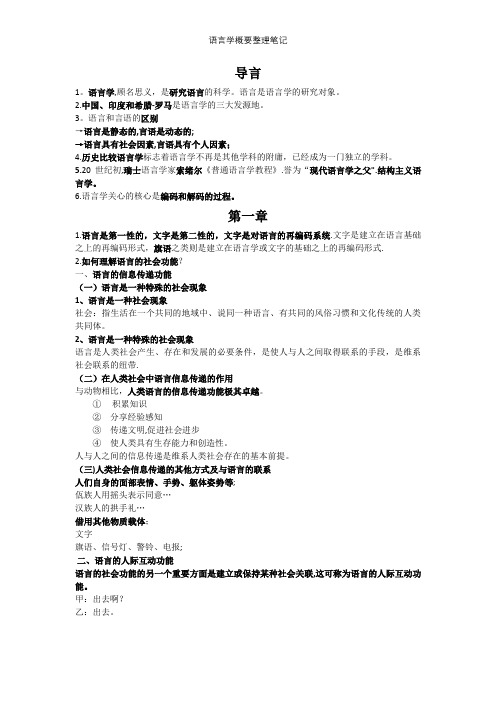
导言1。
语言学,顾名思义,是研究语言的科学。
语言是语言学的研究对象。
2.中国、印度和希腊-罗马是语言学的三大发源地。
3。
语言和言语的区别→语言是静态的,言语是动态的;→语言具有社会因素,言语具有个人因素;4.历史比较语言学标志着语言学不再是其他学科的附庸,已经成为一门独立的学科。
5.20世纪初,瑞士语言学家索绪尔《普通语言学教程》.誉为“现代语言学之父".结构主义语言学。
6.语言学关心的核心是编码和解码的过程。
第一章1.语言是第一性的,文字是第二性的,文字是对语言的再编码系统.文字是建立在语言基础之上的再编码形式,旗语之类则是建立在语言学或文字的基础之上的再编码形式.2.如何理解语言的社会功能?一、语言的信息传递功能(一)语言是一种特殊的社会现象1、语言是一种社会现象社会:指生活在一个共同的地域中、说同一种语言、有共同的风俗习惯和文化传统的人类共同体。
2、语言是一种特殊的社会现象语言是人类社会产生、存在和发展的必要条件,是使人与人之间取得联系的手段,是维系社会联系的纽带.(二)在人类社会中语言信息传递的作用与动物相比,人类语言的信息传递功能极其卓越。
①积累知识②分享经验感知③传递文明,促进社会进步④使人类具有生存能力和创造性。
人与人之间的信息传递是维系人类社会存在的基本前提。
(三)人类社会信息传递的其他方式及与语言的联系人们自身的面部表情、手势、躯体姿势等;佤族人用摇头表示同意…汉族人的拱手礼…借用其他物质载体;文字旗语、信号灯、警铃、电报;二、语言的人际互动功能语言的社会功能的另一个重要方面是建立或保持某种社会关联,这可称为语言的人际互动功能。
甲:出去啊?乙:出去。
人际互动功能表达了说话者的一种主观态度,是一种特殊的信息传递,它指向交际本身.简单地说,就是人在很多情况下是为了交际而交际。
人际互动包括两个方面:-说话者在话语中表达自己的情感、态度、意图;-对受话者施加了影响,得到相应的语言或行动上的反馈,从而达到某种实际效果.交际双方在主观情态表达上是彼此互动的.3.思维是认识现实世界时的动脑筋的过程,也指动脑筋时进行比较、分析、综合以认识现实的能力。
- 1、下载文档前请自行甄别文档内容的完整性,平台不提供额外的编辑、内容补充、找答案等附加服务。
- 2、"仅部分预览"的文档,不可在线预览部分如存在完整性等问题,可反馈申请退款(可完整预览的文档不适用该条件!)。
- 3、如文档侵犯您的权益,请联系客服反馈,我们会尽快为您处理(人工客服工作时间:9:00-18:30)。
1.Linguistics studies not any particular language, but languages in general.2.If a linguistic study aims to describe and analyze the language people atcutally use, it is said to be Descriptive(描述性) - synchronic study(共时研究)If the linguistic study aims to lay down rules for "correct and standard" behaviour in using language, it is said to be Perscriptive(规定性) - diachronic study(动态研究)3.Modern linguistic regards the spoken language as the nature or the primary medium of human language.ngue(语言) refers to the abstract linguistic system shared by all the members of a speech community; parole(话语) refers to the realization of langue in actual use.petence: the ideal(normal) user's knowledge of the rules of his language; Performance: the actual realization of the knowledge in linguistic communications.nguage is a system of arbitrary vocal symbols(语言符号系统) used for human communication.7.Displacement(移位性): It means language can be used to refer to contexts removed from the immediate situations of the speaker.(things which are present of not present, real or imagined matters in the past, present, or future, or far-away places.)8.V oicing(浊音): Vibration of the vocal cords(声带) results in a quality of speech sound called "voicing". It's the feature of all vowels and some consonants.V oiceless(清音): When the vocal cords are drawn wide apart, letting air go through without causing vibration, the sounds produced in such a condition are voiceless.9.Speech organs: the tongue, the uvula(小舌), the soft palate/velum, the hard palate, the teeth ridge/alveolus(齿龈), the teeth and the lips. The tongue is the most flexible, and is responsible for more varieties of articulation(发音) than any other10.English consonants classification: in therms of manner of articulation(发音方式); in terms of place of articulation(发音部位);voicing(浊音) and voiceless(浊音)11.Vowels sounds are differentiated by a number of factors: the position of the tongue in the mouth, the openness of the mouth, the shape of the lips, and the length of the vowels.(舌头位置, 开口度, 唇形, 音长度) 12.Phone(音素): a phonetic unit or segment. A phone doesn't necessarily distinguish meaning; Phoneme(音位): a phonological unit that is of distinctive value.13.Minimal pairs(最小对): when two different forms are identical in every way except for one sound segment which occurs in the same place in the strings, the two sound combinations are said to form a minimal pair.14.Suprasegmental features(音位特征): stress, tone, intonation(重音, 声调, 语调)15.A phonological feature of the English compounds in that the stress of the word always falls on the first element, and the second element receives secondary stress. (重音在另一个音节)16.Open class words: nouns, verbs, adjectives and adverbs. Closed class words: conjunctions, prepositions, articles and pronouns.17.Morphology(形态学) refers to the study of the internal structure of words, and the rules by which words are formed.18.Bound morphemes are never words but always parts of words, like -ish, -able. Free morphemes can constitute words by themselves like: girl,rely. We seldom use bound morphemes alone, we combine all morphemes into longer units and sentences.19.Category refers to a group of linguistic items which fulfill the same or similar funtions in a particular language such as a sentence, a noun phrase or a verb. Major lexical categories are noun, verb, adjective and preposition.20.Phrases that are formed of more than one word usually contain the following elements: head, specifier and complement.21.A certain grammatical mechanism that ensures the appropriate positions that specifiers, heads, complements occupy in phrase structure. Such special type of grammatical mechanism that regulates the arrangement of elements that make up a phrase is called a phrase structure rule.(短语结构规则)22.Not all verbs can take a CP complement. Words that can take CP are not verbs alone; As, Ns and Ps call all take CP.23.Transformation: a special type of rule that can move an element from one position to another.24.Wh question: question beginning with a wh-word.25.Contextualism(语境/情境因素)a word in a new context is a new word.26.Behaviorism(行为主义)27.Sense is concerned with the inherent meaning of the linguistic form.It is the collection of all the feature of the linguistic form; it is abstract and de-contextualized.28.Synonymy(同义)refers to the sameness or close similarity of meaning. Words that are close in meaning are called synonymy.29.Polysemy(一词多义)refers to the same one word may have more than one meaning. This word is called a polysemic.30.Homonymy(同音异义) refers to the phenomenon that words having different meanings have the same form, different words are identical in sound or spelling, or in both.31.Antonymy(反义词) words have oppositeness of meaning.ponential analysis(词义分析成分)is a way proposed by the structural semanticists to analyze word meaning.33.The meaning of a sentence is not the sum total of the meanings of all its components, that is, the meaning of a sentence is not to be worked out by adding up all the meanings of its constituent words. Predication analysis.(句意分析)34.Pragmatics(语用学) it is the study of how speakers of a language use sentences to effect successful communication.35.If the context of language use was left unconsidered it would be impossible to give an adequate description of meaning. What essentially distinguishes semantics and pragmatics is where in the study of meaning the context of use is considered.36.The notion of context is essential to the pragmatics study of language. It is generally considered as constituted by the knowledge shared by the speaker and the hearer.37.It all depends on how we look at it a nd how we are going to analyze it. If we take it as a grammatical unit(语法单位)and consider it as a self-contained unit(独立单元)in isolation from context, then we are treating it as a sentence.38.A speaker might be performing three acts simultaneously(同时地) when speaking: locutionary act, illocutionary act, perlocutionary act.(言内行为, 言外行为, 言后行为)39.According to Searle, speech acts fall into five general categories:1) Representatives: stating or describing, saying what the speaker believes to be true2) Directives: trying to get the hearer to do something3) Commissives: committing the speaker himself to some future course of action4) Expressives: expressing feelings or attitude towards an existing state5) Declarations: bringing about immediate changes by saying something 40.Cooperative principle/CP: 推断题1)The maxim of quantity/信息量过大, 不可2)The maxim of quality/无证据的认为是错的, 不说3)The maxim of relation/不相关的, 不说4)The maxim of manner/含糊不清的, 不说, 要简洁有条理41.Modern English/Old English: changes in phonology, morphology, syntax, lexicon, semantic components(音, 形, 句法, 词, 语义成分).42.判断用哪种方法造新词: coinage(创新法), clipped words(剪切法), blending(混拼法), acronyms(首字母缩略), back-formation(逆构法), functional shift(功能转变法), borrowing(借用法)43.判断词义扩大缩小: widening(词义扩大),narrowing(词义缩小)44.Speech community is defined as group of people who from a community and share the same language or a particular variety of a language.45.A social group may distinguish itself form the rest of the community by: the educational background, the occupation, the gender, the age, or the ethnic affiliation of its members.46.Sociolinguistic(社会语言学) studies three types of speech varieties: regional dialects(地域方言), sociolects(社会方言), registers(语域) 47.A regional dialect is a linguistic variety used by people living in the same geographical region. It is associated with separation caused by physical conditions.48.Social dialect has to do with separation brought about by different social conditions. Social-class dialect/sociolect, refers to the linguistic varieties characteristic of a particular social class.49.Register(语域或使用域)/functional speech variety(功能变体)/situational dialect(情境方言)50.Register: the type of language which is selected as appropriate to they type of situation.51.Three social variables(社会变量) that determine the register: field of discourse(话语范围), tenor of discourse(基调), model of discourse(方式).52.Linguistic relativity(语言相对性): different language offer people different ways of expressing the world around. This independence of language and thought is now known as Sapir-Whorf hypothesis(SWH).认为语言结构决定人类思维方式及行动方法的假说.53.Hypothesis/SWH is interpreted in two ways: Strong version believes that the language patterns determine people's thinking and behaviour, the weak one holds that the former influence the latter.54.Any linguistic sign(语言符号) may be simultaneously of a denotative(本体义), connotative(含蓄义), or iconic(形象义) kind of meanings.55.In addition to the fact that different language may have different divisions of colour, different languages entail different color related associations.56.The increasing cultural diffusion(文化传播) has been recognized a tendency of cultural imperialism(文化帝国主义) owing to linguistic imperialism(语言帝国主义).nguage acquisition(言语习得) refers to the child's acquisition of his mother tongue, i.e. How the child comes to understand and speak the language of his community .58.Traditional behaviorists(行为主义者) view language as behavior and believe that language learning is simply a matter of imitation and habit formation.59.Children need access to the samples of a natural language to activate the LAD(language acquisition device), which enables them to discover his language's structure by matching the innate(先天的) knowledge of basic grammatical system to that particular language. Chomsky prefers this innate endowment as Universal Grammar/UG(普遍语法)60.Only when conversations provide the right level of language that children are capable of processing can they facilitate children's language acquisition, otherwise it's insufficient.61.All child language acquisition theories talk about the roles of two factors to different degrees: the linguistic environment children are exposed to, the age they start to learn the language.62.Critical Period Hypothesis(关键期假设): the LAD works successfully only when it is stimulated at a specific and limited time period for language acquisition.63.Stages in child language development: phonological development, vocabulary development, grammatical development64.In learning second language distinguish was made between positive transfer (facilitate target language) and negative transfer(interfere) 65.Interlanguage(中介语)was established as learners' independent system of the second language which is neither the native language nor the second language, but a continuum or approximation from his native language to the target language.66.Individual differences: Language aptitude(语言学能): refers to a natural ability for learning a second language. Cognitive mechanism(认知机制). Motivation(学习动机): learner's attitudes and affective state or learning drive impacts strongly. A ge of acquisition(习得年龄). Personality(性格)...CPH存在于第二外语习得吗?。
